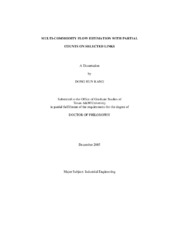| dc.description.abstract | The purpose of this research is to formulate a multi-commodity network flow model
for vehicular traffic in a geographic area and develop a procedure for estimating traffic
counts based on available partial traffic data for a selected subset of highway links. Due
to the restriction of time and cost, traffic counts are not always observed for every
highway link. Typically, about 50% of the links have traffic counts in urban highway
networks. Also, it should be noted that the observed traffic counts are not free from
random errors during the data collection process. As a result, an incoming flow into a
highway node and an outgoing flow from the node do not usually match. They need to
be adjusted to satisfy a flow conservation condition, which is one of the fundamental
concepts in network flow analysis.
In this dissertation, the multi-commodity link flows are estimated in a two-stage
process. First, traffic flows of "empty" links, which have no observation data, are filled
with deterministic user equilibrium traffic assignments. This user equilibrium
assignment scheme assumes that travelers select their routes by their own interests
without considering total cost of the system. The assignment also considers congestion
effects by taking a link travel cost as a function of traffic volume on the link. As a result,
the assignment problem has a nonlinear objective function and linear network constraints.
The modified Frank-Wolfe algorithm, which is a type of conditional gradient method, is
used to solve the assignment problem. The next step is to consider both of the observed traffic counts on selected links and
the deterministic user equilibrium assignments on the group of remaining links to
produce the final traffic count estimates by the generalized least squares optimization
procedure. The generalized least squares optimization is conducted under a set of
relevant constraints, including the flow conservation condition for all highway
intersections. | en |


